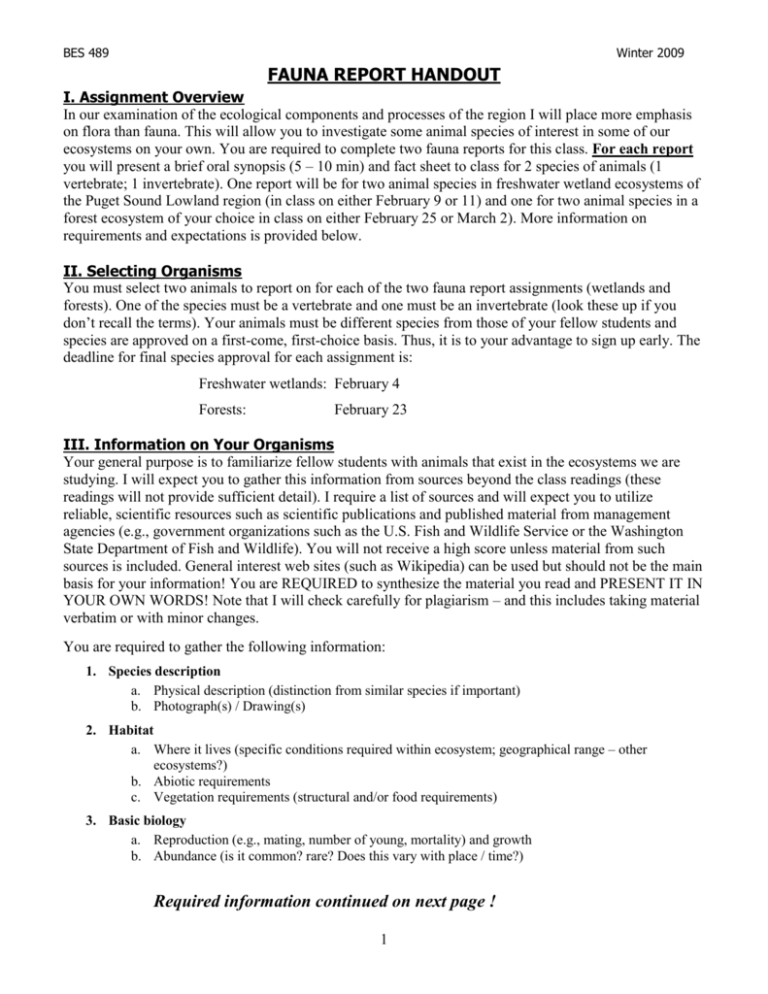Fauna Report Handout
advertisement

BES 489 Winter 2009 FAUNA REPORT HANDOUT I. Assignment Overview In our examination of the ecological components and processes of the region I will place more emphasis on flora than fauna. This will allow you to investigate some animal species of interest in some of our ecosystems on your own. You are required to complete two fauna reports for this class. For each report you will present a brief oral synopsis (5 – 10 min) and fact sheet to class for 2 species of animals (1 vertebrate; 1 invertebrate). One report will be for two animal species in freshwater wetland ecosystems of the Puget Sound Lowland region (in class on either February 9 or 11) and one for two animal species in a forest ecosystem of your choice in class on either February 25 or March 2). More information on requirements and expectations is provided below. II. Selecting Organisms You must select two animals to report on for each of the two fauna report assignments (wetlands and forests). One of the species must be a vertebrate and one must be an invertebrate (look these up if you don’t recall the terms). Your animals must be different species from those of your fellow students and species are approved on a first-come, first-choice basis. Thus, it is to your advantage to sign up early. The deadline for final species approval for each assignment is: Freshwater wetlands: February 4 Forests: February 23 III. Information on Your Organisms Your general purpose is to familiarize fellow students with animals that exist in the ecosystems we are studying. I will expect you to gather this information from sources beyond the class readings (these readings will not provide sufficient detail). I require a list of sources and will expect you to utilize reliable, scientific resources such as scientific publications and published material from management agencies (e.g., government organizations such as the U.S. Fish and Wildlife Service or the Washington State Department of Fish and Wildlife). You will not receive a high score unless material from such sources is included. General interest web sites (such as Wikipedia) can be used but should not be the main basis for your information! You are REQUIRED to synthesize the material you read and PRESENT IT IN YOUR OWN WORDS! Note that I will check carefully for plagiarism – and this includes taking material verbatim or with minor changes. You are required to gather the following information: 1. Species description a. Physical description (distinction from similar species if important) b. Photograph(s) / Drawing(s) 2. Habitat a. Where it lives (specific conditions required within ecosystem; geographical range – other ecosystems?) b. Abiotic requirements c. Vegetation requirements (structural and/or food requirements) 3. Basic biology a. Reproduction (e.g., mating, number of young, mortality) and growth b. Abundance (is it common? rare? Does this vary with place / time?) Required information continued on next page ! 1 BES 489 Winter 2009 4. Basic ecology a. Relationships – are there important ecological relationships not described above (e.g., competition, mutualisms, etc.) b. Ecological role – does this organism play important roles in the ecosystem not described above? You may find that there is other important information that you wish to provide that I have not included on the list above. IV. In-class Presentation You will be expected to make a brief presentation, highlighting the information gathered on your organisms. The presentation should be between 5 and 10 minutes in length. I will expect the presentation to be well organized and cleanly presented (practice!). You should use PowerPoint for your presentation so that you can easily present photographs, maps of species ranges, and other important visual material in addition to text. If you would like to use some other presentation medium, please consult with me in advance. You are required to provide me an electronic copy of your presentation (e.g., a PowerPoint file) – either by email, CD, or arranging to have me copy it. V. Fact Sheet You are required to turn in a fact sheet that summarizes the information you found for each organism AND PROVIDE COPIES FOR ALL OF YOUR FELLOW STUDENTS at the time of your presentation. The fact sheet should include a summary of the information presented in an explicit structure, such as that outlined above in part III. It should also contain a list of sources in a clear and consistent citation format (your choice on which format – just be consistent!). There are no page limitations for the fact sheets, but I expect that you should be able to produce a good, concise fact sheet for each of your species in the range of 1-2 pages. Be sure to include a clear photograph or drawing of the species in your fact sheet (and a range map is a good idea if it is available and/or important). VI. Grading You will be graded on both the information you present and the clarity with which it is presented (for both the oral presentation and the fact sheet). Each fauna assignment is worth 30 points. For one assignment, each of the two species will be graded for 15 points with 8 points allotted to the fact sheet and 7 points for the oral presentation. 2











